MMH PROJECT SITES SUCCESSFULLY MOVE FROM STANDSTILL TO FULL FLIGHT
Across the country, the Unlock came along with the challenges of resuming activities safely and efficiently. “We could not afford to simply return to action, we had to roar back to action,” comments Anupam Kumar, Executive Vice President & Head – MMH SBG. “The asking rate has gone up significantly and therefore we had to hit the board running and keep running till we catch up for time lost.” Sites have certainly hit the board running but many have found the board slippery. There remains the constant threat of the spread of COVID-19 infections; the need to rigorously enforce the elaborate safety precautions that are alien to many; the depleting labour force and the induction of fresh workmen; the disruption of supply lines requiring quick realignment of material procurement plans; the reluctance of clients and customers to readily adopt to the new normal of increased digital and ‘virtual’ interactions. The challenges are many.

Building belief to return
Project leadership and managers across geographies soon realized that building belief amongst the workforce was the first imperative to get them back to work. Regular and cogent communication have helped as Project Manager, Mukesh Kumar’s team at the 2×660 MW NTPC Khargone Super Critical Power Plant project proved. By forming a dedicated COVID-19 Communications team, they developed and disseminated continuous messaging to employees and workmen to help them overcome their fear and anxiety. Project Director, Hare Ram, at his Mansourah Massarah Gold Project (MMGP) in the Kingdom of Saudi Arabia, adds, “We worked at convincing our workforce that there are ways and means to fight this global pandemic and that the company and site leadership are well equipped and well prepared to keep them safe provided they strictly follow our advisories and SOPs.”

“We could not afford to simply return to action, we had to roar back to action. The asking rate has gone up significantly and therefore we had to hit the board running and keep running till we catch up for time lost.”
Anupam Kumar
Executive Vice President & Head –
MMH SBG
Facing the labour exodus as soon as the Unlock was announced, site personnel struggled to convince workmen to stay and work though they were already a nervous and agitated lot. Some projects succeeded in their effort like the team at the MCL Bhubaneswari Project as Project Manager, C N Padhi says, “We retained 50-60% of our workmen and even after the Unlock, 80-90% of our workforce have stayed with us. We succeeded by motivating them, boosting their morale, and gaining their confidence to return to work.”
At the Utkal Alumina Expansion Project, Project Manager, Prasanta Tikadar and his team evolved a
3-level system to ensure that its business as usual in the new normal. “Our COVID Watchers are from among the workmen themselves who have been mandated to ensure SOP compliance at site,” explains Prasanta. “They report in to the COVID Warriors who are predominately EHS and admin staff who in turn appraise the COVID Task Force Committee about how SOP guidelines are being followed.” This system has since been adopted by several other MMH sites with encouraging results.

Civil work proceeding at the MCL – Bhubaneswari project with
social distancing

“We retained 50-60% of our workmen and even after the Unlock, 80-90% of our workforce have stayed with us. We succeeded by motivating them, boosting their morale, and gaining their confidence to return to work.”
C N Padhi
Project Manager,
MCL Bhubaneswari Project

ROM pad wall at MMGP
Screening and induction
Separating the existing workforce from the newly inducted workmen was vital to maintain safety by preventing all interactions until the latter had been tested, screened, and cleared. At MMGP, the team followed an elaborate screening process as Swagath Gowda, Assistant Manager – EHS explains. “After mobilization, the workforce was initially quarantined at the Riyadh Camp for 5 days and on the 6th day, if found negative after the PCR test, they would be allowed to move to the site on the 7th day where they were kept under observation for another 3 days and deployed at project site only after the necessary Medical / COVID screening, EHS induction and training.” Hare Ram mentions the formation of a ‘COVID Crisis Command Centre – 4C’ to tackle the situation. “It had our client, the PMC, Bechtel and our consortium partner, Outotec,” he shares, “and it involved the senior management, the medical team, staff members and together we did a lot to visualize the situation and seek ways for an effective
and gradual restart.”
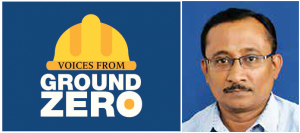
“Our COVID Watchers are from among the workmen themselves. They report in to the COVID Warriors who are predominately EHS and admin staff who in turn appraise the COVID Task Force Committee about how SOP guidelines are being followed.”
Prasanta Tikadar
Project Manager, Utkal Alumina Expansion Project
Remobilization of manpower has become extremely challenging, as Mukesh Kumar admits and with travel restrictions, things have been tougher. “We have to make do with the locally available labour for activities like road and drain construction, precast concreting and the like. We have, in the meantime, identified and developed local subcontractors too, that is helping in our manpower sourcing effort.”

“To comfort the agitated workmen, we placed our administrative and technical staff at strategic locations like Patna, Jamshedpur, Varanasi and Gorakhpur. We successfully mobilized 10,000 workmen in the period from July to September and are now back to
full action.”
Bhanu Pratap Singh
Project Director,
JSW Project site at Dolvi
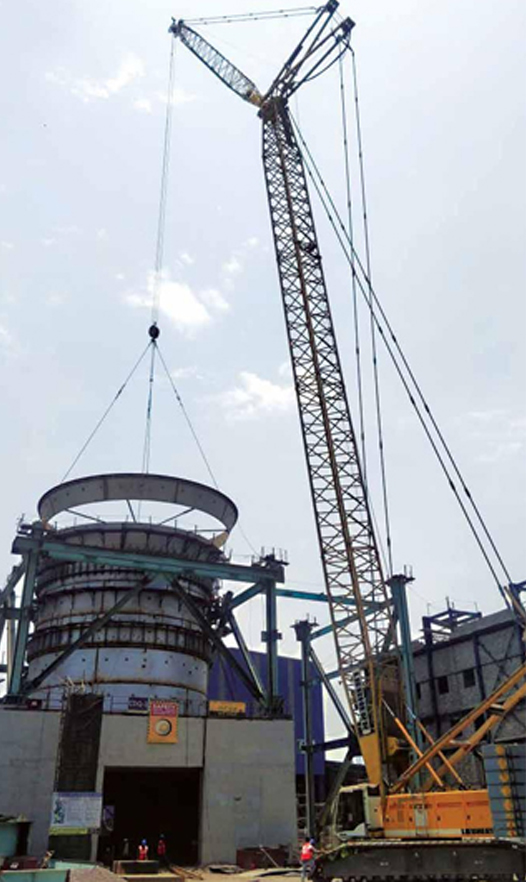
Erection of main chamber shell at CDQ 3, JSW, Dolvi project
Ups, downs and ups
For Project Director, Bhanu Pratap Singh, and his team at the JSW Project site at Dolvi, in Maharashtra’s Raigad district, the impact of the pandemic has been almost like a rollercoaster. The site was at the peak of its execution phase with almost 300 staff and 10,000 workmen when COVID-19 struck. “It played havoc with the morale of our workforce and many of them immediately left for their native places and even after resumption of activities, we only had a terribly depleted labour force,” shares a worried Bhanu. “Many were frightened to travel back and resume work at site.”
Desperate situations demand desperate measures. To tackle this problem, the team came up with a smart ploy. “To comfort the agitated workmen, we placed our administrative and technical staff at strategic locations like Patna, Jamshedpur, Varanasi and Gorakhpur,” shares Bhanu. “We took the support of teams at Kolkata and other MMH project sites to drive mobilization.” The ploy worked wonders because the presence of the organization’s staff boosted the morale of the workmen and many of them were convinced enough to travel back to site. “We successfully mobilized 10,000 workmen in the period from July to September and are now back to full action,” declares a very proud and pleased Bhanu.
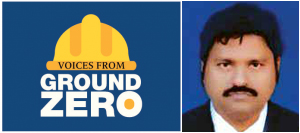
“Our business continuity plan critically involves helping our client understand the risks involved while implementing measures to mitigate them to ensure that our operations continue seamlessly. Our client has been with us every step of the way.”
Satish Patnaik
Senior Manager, FA&A, UAIL Project
Back to action
Across project sites, operations have resumed in a well-planned, phased manner adopting a risk-adjusted
strategy. Prasanta says that return to action at the UAIL site was based on 4 broad aspects: mobilization of manpower, revision of SOPs, budgeting, and resource utilization. “Mobilization in a remote place like Tikiri is not easy,” he shakes his head, “but thanks to WISA, we had the coordinates of our previous workmen and could reach out to them, convince them to return and, in some cases, even provide special transport.”

Top view of the Feedbin building at the Utkal Alumina Expansion project
“In the midst of a crisis like this, it is important to win the client’s trust and confidence,” remarks Satish Patnaik, Senior Manager – FA&A, UAIL project. “Our business continuity plan critically involves helping our client understand the risks involved while implementing measures to mitigate them to ensure that our operations continue seamlessly. Our client has been with us every step of the way,” he adds reassuringly.

“With travel restrictions, quarantining and self-isolation procedures, no OEM representative was able to come to site, so our in-house execution and quality teams took on the task and successfully commissioned three wagon tipplers and two stacker reclaimers with only virtual guidance from the OEM.”
Mukesh Kumar
Project Manager,
2×660 MW NTPC Khargone Super Critical
Power Plant Project
The MMGP team had four teams to look at key areas as Dhiman Bose, Manager – Systems explains. “Security controlled outsiders and locals entering our project; the medical team monitored our health status. Another team was tasked to prepare the required documents, procedures & SOPs, implement control measures during work while the mobilization team planned and restarted operations.”

Crushed ore silo at MMGP
For the Khargone team, commissioning major equipment like Stacker Reclaimers and Wagon Tipplers in the CHP system was critical as it involved hydraulic systems and are best done in the presence of OEM personnel. “With travel restrictions, quarantining and self-isolation procedures, no OEM representative was able to come to site,” informs Mukesh, “so our in-house execution and quality teams took on the task and successfully commissioned three wagon tipplers and two stacker reclaimers with only virtual guidance from the OEM.” He sits back with a satisfied look.
Having more than doubled their workforce from 700 to 1,500+, the MMGP team has pressed the pedal on activities like mobilizing P&M and concrete production.
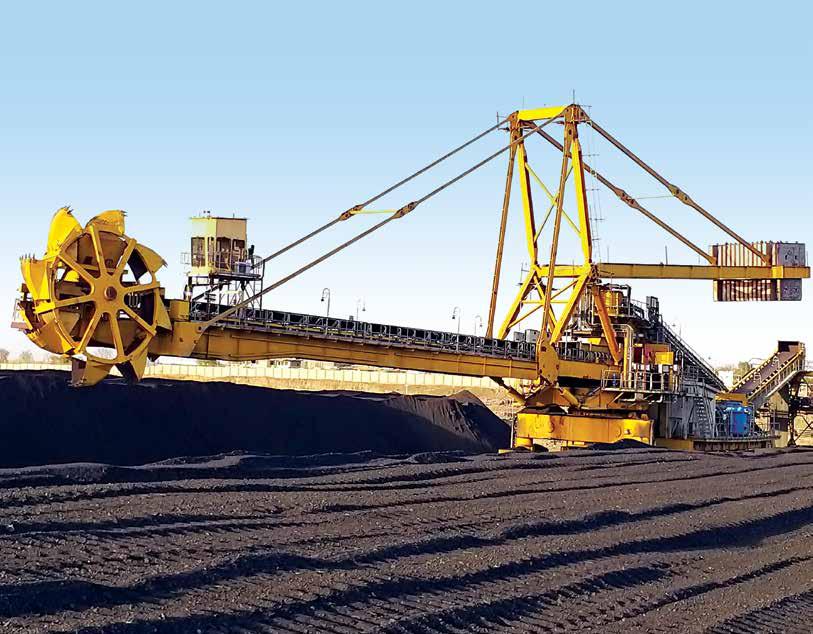
A stacker reclaimer at work at the CHP package, NTPC Khargone
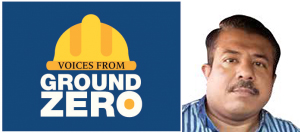
“Security controlled outsiders and locals entering our project; the medical team monitored our health status. Another team was tasked to prepare the required documents, procedures & SOPs, implement control measures during work while the mobilization team planned and
restarted operations.”
Dhiman Bose
Manager,
Mansourah Massarah Gold Project
Cracking the sourcing challenge
With all forms of interstate and intrastate movement at a standstill, sites have been struggling with the disruption of supply chains as Mukesh points out. “Oxygen is a vital consumable at site for mechanical and civil works as all gas cutting works are dependent on it. Since O2 was unavailable, our site supply chain team had to make alternate arrangements for priority delivery.” Further, the team developed in-house machine cutting facilities to keep up the pace of works. Bulk material supply had also diminished from existing sources with the available material insufficient for the process of concreting. Again, Mukesh’s team had to adopt a more diversified approach by developing alternative suppliers to keep the ball rolling.

“After an extensive survey for new vendors and new brands throughout KSA, we decided on some readily available materials in the market that met our minimum requirements to maintain continuity of site operations.”
Hare Ram
Project Director,
Mansourah Massarah Gold Project
For MMGP, Saudi Arabia was still in a lockdown with restrictions on intercity movement of vehicles when work resumed. “Most of our vendors were either totally or partially closed and our problem soon became more severe due to the restriction on imports, especially from China,” explains Stores In-charge, Kaustov Bose. “Our registered stockists ran out of stock of many of our approved materials.” The need of the hour was for a more flexible procurement strategy rather than waiting for the approved brands to become available. Hare Ram picks up the story, “With the market situation very uncertain and none of our suppliers able to commit to delivery schedules for the out-of-stock materials, we were compelled to seek alternative materials and sources. After an extensive survey for new vendors and new brands throughout KSA, we decided on some readily available materials in the market that met our minimum requirements to maintain continuity of site operations.” Having achieved August’s concrete casting target and with things rolling, Hare Ram is confident of further upping the tempo going forward.
We hope he does and with him all the projects sites of MMH SBG.